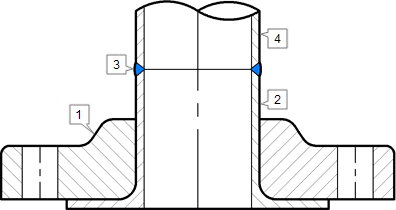Zhengzhou Huitong Pipeline Equipment Co.,Ltd. |
|
ASME B16.5 JIS B2220 Alloy Nickel 200 Lap Joint LJ Flange For Chemical Plant
1. What is a lap joint flange?
A Lap Joint Flange is a two piece device that is much like a weld-neck flange but
also like a loose slip-on flange. One piece is a sleeve called a
‘Stub-end” and is shaped like a short piece of pipe with a weld
bevel on one end and a narrow shoulder on the other end called the
hub. The hub is the same outside diameter as the raised face
(gasket contact surface) of a weld neck flange. The thickness of
the hub is normally about ¼” to 3/8″. The back face of the hub has
a rounded transition (or inside fillet) that joins the hub to the
sleeve.
The other piece of a Lap Joint Flange is the backing flange. This
flange has all the same common dimensions (O.D., bolt circle, bolt
hole size, etc.) as any other flange however it does not have a
raised face. One side, the backside, has a slight shoulder that is
square cut at the center or pipe hole. The front side has flat face
and at the center hole an outside fillet to match the fillet of the
“Stub-end” piece. The flange part of the Lap-joint flange assembly
is slipped on to the stub-end prior to the sleeve being welded to
the adjoining pipe or fitting. The flange itself is not welded or
fixed in any way. It is free to spin for proper alignment with what
ever it is joining to.
The “Stub-end” can normally be purchased in two lengths. There is a
short version, about 3″ long and a long version of about 6″ long.
It is prudent for the piping designer to know which version is in
the piping specification.
Because of it’s two piece configuration, the Lap Joint Flange
offers a way to cut cost or simplify work. The cost saving comes
when the piping system requires a high cost alloy for all “wetted”
parts to reduce corrosion. The sleeve or Stub-end can be the
required higher cost alloy but the flange can be the lower cost
forged carbon steel.
The lap joint flange can be rotated which can be useful when fixing
issues with bolt hole alignment. When designing a piping system,
lap joint flanges should not be considered solely to alleviate poor
alignment during construction. Good design practice should not need
to include poor construction quality. However, if the piping needs
to be frequently dismantled for inspection or cleaning,
consideration should be made for lap joint flanges. They give the
ability to swivel flanges and to align bolt holes which simplifies
the assembly of large diameter or unusually stiff piping.
Lap joint flanges are usually used in low pressure applications and
are not suitable when there are high loads on the flange pair. Some
types of piping require the use of lap joint flanges. For example,
metallic pipe that has been plastic lining may have lap joint
flanges.
Using lap joint flanges might be an option for saving costs when
the piping is made of exotic materials. By using a lap joint
flange, the wetted materials would consist of the exotic materials
and the flange would be carbon steel. Since the flange doesn’t ever
come in contact with the process fluid, it would not be affected by
the fluids.
2. Buying tips
Certain factors to consider are as follows:
3. Key Features:
4. Advantages of Lap Joint Flanges:
Lap Joint flanges have certain special advantages over other
flanges. These are as follows:
The lap joint flange is practically identical to a slip-on flange except it has a radius at the intersection of the bore and flange face. This radius is necessary to have the flange accommodate a lap joint stub end. Normally, a lap joint flange and a lap joint stub end are mated together is an assembly system.

LAP JOINT FLANGE’S DRAWING:

These flanges are nearly identical to a Slip On flange with the exception of a radius at the intersection of the flange face and the bore to accommodate the flanged portion of the Stub End.
| Material Grade | Nickel Alloy Steel | ASTM/ASME B/SB564 UNS N02200(NICKEL 200), UNS N04400(MONEL 400), | |
| UNS N08825( INCOLOY 825), UNS N06600(INCONEL 600), | |||
| UNS N06601(INCONEL 601), UNS N06625(INCONEL 625), UNS N10276(HASTELLOY C276), | |||
| ASTM/ASME B/SB160 UNS N02201(NICKEL 201), ASTM B/SB472 UNS N08020(Alloy 20) | |||
| Copper Alloy | ASTM/ASME B/SB151 UNS C70600(CuNi 90/10), C71500(CuNi 70/30) | ||
| Stainless Steel | ASTM/ASME A/SA182 F304,304L,304H,309H,310H,316,316H,316L,316LN, | ||
| 317,317L,321,321H,347,347H | |||
| Duplex and Super Duplex Steel | ASTM/ASME A/SA182 F44,F45,F51,F53,F55,F60,F61 | ||
| Carbon steel | ASTM /ASME A/SA105(N) | ||
| Low Temp Carbon Steel | ASTM/ASME A/SA350 LF2 | ||
| High Yield Carbon Steel | ASTM/ASME A/SA694 F52, F56 F60, F65, F70 | ||
| Alloy Steel | ASTM/ASME A/SA182 GR F5,F9, F11,F12,F22,F91 | ||
| Titanium | ASTM/ASME B/SB381 Grade 2, Grade 5, Grade 7 | ||
